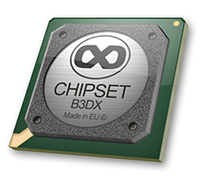Icera acquires Sirific; eyes $2B IPO in 2010
 Monday 07th April 2008, 06:12:00 PM, written by Arun
Monday 07th April 2008, 06:12:00 PM, written by Arun
Icera has gotten attention for a variety of reasons. From a business perspective, Icera's CEO & Founder Stan Boland was previously responsible for Element 14, which was sold to Broadcom for $660M, a 32x return on investment for the venture capitalists. Icera has also always been a very ambitious play - their ambition has been to become the 'European Broadcom' from the start. They've got the capital to make that claim credible too: they raised $140M so far, while Sirific (with which the merger will close in Q2) raised $60M. Combined with their goal to raise another $100M this year, that represents no less than $300M - very likely the most highly funded semiconductor startup in existence today, if not ever.
And then there's the technical perspective, which is even more impressive: Icera's current and future chips use a very high amount of true full-custom logic, and they have the only baseband processor in the industry with no fixed-function units whatsoever. That's right; it's 100% software. Seems massively inefficient? It isn't. They claim to have better performance, lower die size and equal or lower power compared to everyone else in the industry. And we're more than willing to believe that given their truly unique architecture.
We won't go into the details of their architecture here, because it will be one of a few examples in the first part of an article series on Computation Architectures which we hope to start publishing sometime next week. So that's the first reason why we are reporting this story - it's a key announcement for a company with a unique and exciting architecture which you'll hear more about from us shortly.
And then there's the second reason: the business implications it has on the handheld market, including multimedia and application processors, both business-wise and technology-wise. But before we can properly analyze that, we must consider what makes Sirific unique. Their technology may not be quite as revolutionary as Icera's, but they're hardly your average RF company either. Let's put it this way: how many companies are planning on releasing a RF-only chip on 65nm this year?
You (maybe) guessed it: Sirific is one of a few companies which is leading the pack in terms of 'digitizing' radio technology; unlike many of their competitors, they do benefit very significantly from migrating to lower process nodes, both in terms of die area and power consumption. This does make them a very attractive option for a long-term high-integration roadmap. Based on comments from Stan Boland, we can conclude that true single-chip integration isn't the highest priority, but we would still expect something along these lines to be a realistic roadmap, although the timeframes are hard to estimate:
- 65nm Baseband + 65nm RF (2G/3G/HSPA+(?)) + 180nm Analogue SiP or Dual-Package. [Mid-2008?]
- 65nm Baseband + 65nm RF (2G/3G/HSPA+) SiP or Dual-Package. (?)
- 40nm Baseband + ??nm RF (2G/3G/4G LTE) SiP or Dual-Package. [Mid-2009?]
- 40nm Baseband + RF (2G/3G/HSPA+) SoC. [Late 2009/Early 2010?]
This is also taking into consideration comments by Sirific in early 2006 that clearly indicated they believed in Baseband+RF integration in the lower-end parts of the market (see second-to-last paragraph in this article).
Either way, one thing is clear: Icera now has what it takes to become a very large player in the baseband market, especially if we are to believe Stan Boland's claims (same source as above; once again, we are willing to believe it): "we have a technically superior product to the Qualcomm product, our product is smaller, cheaper and with better performance than Qualcomm. We expect to have 33 per cent market share in the data card space by the end of next year."
The consequences in the mobile phone market should be obvious: this increased competition is clearly a positive development for application processor companies without their own 3G baseband IP, including Texas Instruments, NVIDIA and Samsung. Today, many application processors and multimedia processors are paired with 'multimedia basebands' that replicate functionality and increase costs, making low-integration APs even less attractive.
Icera hopes to achieve a major IPO in the 2010 timeframe (although this has already been delayed quite a bit from the original plans and could be delayed again) with a valuation of $1.5 to $2.0B, according to guardian.co.uk. If they maintain their power and die size advantages on 40nm, we wouldn't be surprised a single bit if they soon became even much larger than that. What they need now is traction in the mobile phone market, and a strategic partnership (including SiP ideally) with an application processor company (or several) would go a long way to achieving that, benefiting both sides of the deal.
Tagging
Related corelogic News
STMicroelectronics buys NXP's wireless business
Latest ARM software promises console-quality 3D gaming on mobiles
Tiny RV620 and G98 die sizes leak out
Wireless HD video chipset, WHDI, now available
NVIDIA's MCP78 IGP chipsets to launch this November
Analyst expects 30% increase for TSMC shipments in Q3
US chip fabrication equipment sales rise in May
